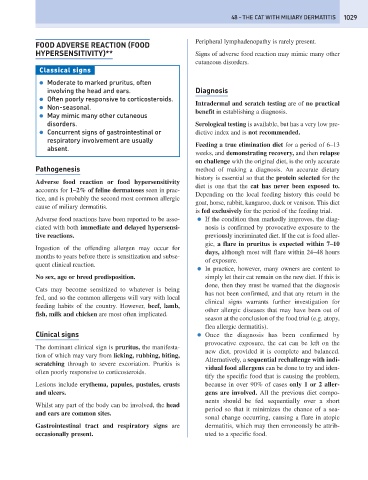Page 1037 - Problem-Based Feline Medicine
P. 1037
48 – THE CAT WITH MILIARY DERMATITIS 1029
Peripheral lymphadenopathy is rarely present.
FOOD ADVERSE REACTION (FOOD
HYPERSENSITIVITY)** Signs of adverse food reaction may mimic many other
cutaneous disorders.
Classical signs
● Moderate to marked pruritus, often
involving the head and ears. Diagnosis
● Often poorly responsive to corticosteroids.
Intradermal and scratch testing are of no practical
● Non-seasonal.
benefit in establishing a diagnosis.
● May mimic many other cutaneous
disorders. Serological testing is available, but has a very low pre-
● Concurrent signs of gastrointestinal or dictive index and is not recommended.
respiratory involvement are usually
Feeding a true elimination diet for a period of 6–13
absent.
weeks, and demonstrating recovery, and then relapse
on challenge with the original diet, is the only accurate
Pathogenesis method of making a diagnosis. An accurate dietary
history is essential so that the protein selected for the
Adverse food reaction or food hypersensitivity
diet is one that the cat has never been exposed to.
accounts for 1–2% of feline dermatoses seen in prac-
Depending on the local feeding history this could be
tice, and is probably the second most common allergic
goat, horse, rabbit, kangaroo, duck or venison. This diet
cause of miliary dermatitis.
is fed exclusively for the period of the feeding trial.
Adverse food reactions have been reported to be asso- ● If the condition then markedly improves, the diag-
ciated with both immediate and delayed hypersensi- nosis is confirmed by provocative exposure to the
tive reactions. previously incriminated diet. If the cat is food aller-
gic, a flare in pruritus is expected within 7–10
Ingestion of the offending allergen may occur for
days, although most will flare within 24–48 hours
months to years before there is sensitization and subse-
of exposure.
quent clinical reaction.
● In practice, however, many owners are content to
No sex, age or breed predisposition. simply let their cat remain on the new diet. If this is
done, then they must be warned that the diagnosis
Cats may become sensitized to whatever is being
has not been confirmed, and that any return in the
fed, and so the common allergens will vary with local
clinical signs warrants further investigation for
feeding habits of the country. However, beef, lamb,
other allergic diseases that may have been out of
fish, milk and chicken are most often implicated.
season at the conclusion of the food trial (e.g. atopy,
flea allergic dermatitis).
Clinical signs ● Once the diagnosis has been confirmed by
provocative exposure, the cat can be left on the
The dominant clinical sign is pruritus, the manifesta-
new diet, provided it is complete and balanced.
tion of which may vary from licking, rubbing, biting,
Alternatively, a sequential rechallenge with indi-
scratching through to severe excoriation. Pruritis is
vidual food allergens can be done to try and iden-
often poorly responsive to corticosteroids.
tify the specific food that is causing the problem,
Lesions include erythema, papules, pustules, crusts because in over 90% of cases only 1 or 2 aller-
and ulcers. gens are involved. All the previous diet compo-
nents should be fed sequentially over a short
Whilst any part of the body can be involved, the head
period so that it minimizes the chance of a sea-
and ears are common sites.
sonal change occurring, causing a flare in atopic
Gastrointestinal tract and respiratory signs are dermatitis, which may then erroneously be attrib-
occasionally present. uted to a specific food.

